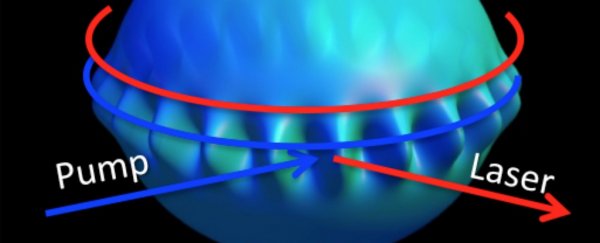Researchers have developed the world's first water-wave laser, demonstrating that lasers can, in fact, be created by interactions between light and water waves.
These new lasers offer researchers incredible control, and could help them to use lasers on tiny 'lab-on-a-chip' technologies, enabling them to more effectively study microscopic cells and test different drug therapies that could lead to better healthcare down the road.
So what is a water-wave laser?
To produce normal laser light – the type that brings your DVDs to life, or torments your cat – a single wavelength of light, called monochromatic light, that's rendered the same frequency (coherent), and is focussed into a single point (collimated) by exciting the electrons inside it.
When that happens, you get a high-energy laser beam that stays focused for vast distances without spreading out like, say, a beam of light from a flashlight would.
"A typical laser can be created when the electrons in atoms become 'excited' by energy absorbed from an outside source, causing them to emit radiation in the form of laser light," said the team, from the Technion-Israel Institute of Technology in Haifa.
So how the heck did they manage to make a laser emission from a water wave? Well, first they had to know what they were up against.
According to the team, the main reason water-wave lasers haven't been explored in the past is because the frequency of water wave oscillation on the surface is a whole lot lower than a light wave, suggesting that the production of a laser emission would probably be highly inefficient.
Here's a model the team made of a water droplet's oscillation:
 Technion-Israel Institute of Technology
Technion-Israel Institute of Technology
To overcome that slow oscillation, they created a device that used an optical fibre to deliver light to a small droplet of octane and water.
This tiny bit of light introduced to the droplet interacts with the waves of the water, bouncing back and forth until enough energy has built up that the light can leave the droplet like a laser butterfly emerging from a watery cocoon.
"The interaction between the fibre optic light and the minuscule vibrations on the surface of the droplet are like an echo," the team said, "where the interaction of sound waves and the surface they pass through can make a single scream audible several times."
"In order to increase this echo effect in their device, the researchers used highly transparent, runny liquids, to encourage light and droplet interactions."
The coolest part is that the introduced light from the optical fibre is enough to deform the water droplet because water is, after all, a liquid.
While it seems obvious that any sort of energetic particle smashing into a super tiny droplet of water would make it deform a bit, normal optomechanical devices are hardier.
This deformation, about a million times greater than that of current laser-producing devices, allows for greater control, which could be extremely helpful once the technology is developed further and used in a laboratory setting to study cells.
The team's work was published in Nature Photonics.
